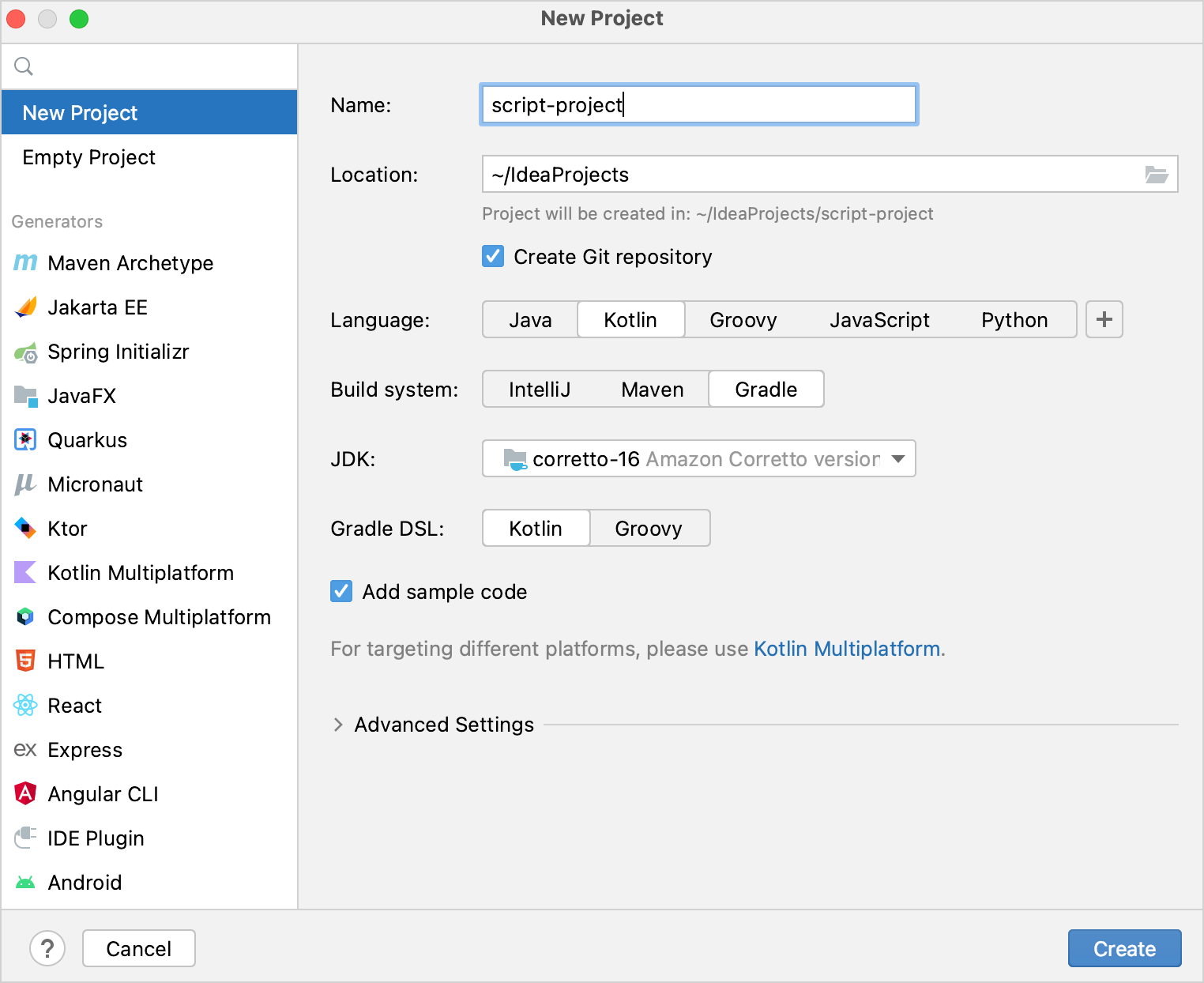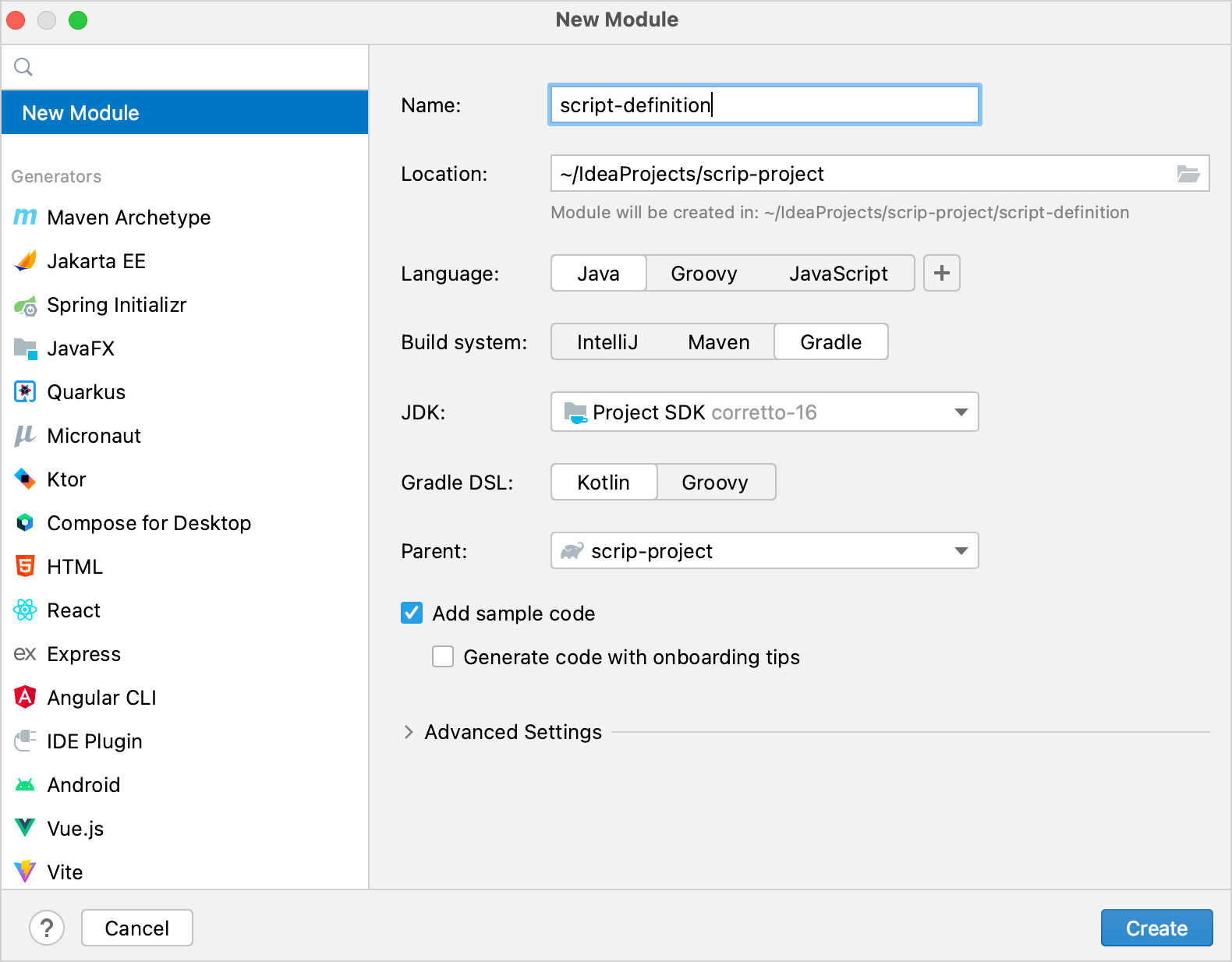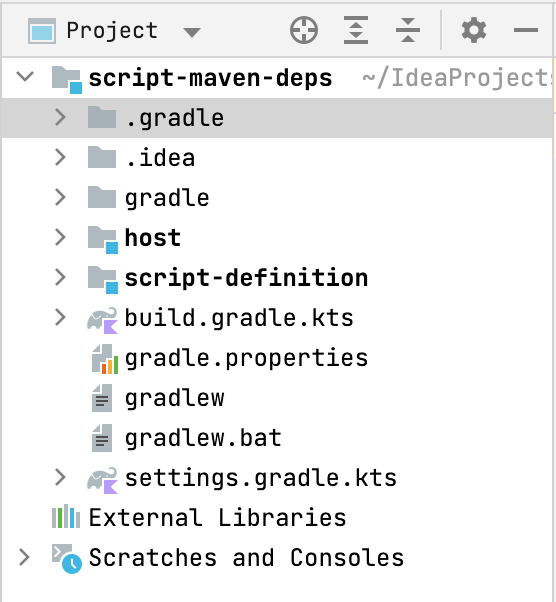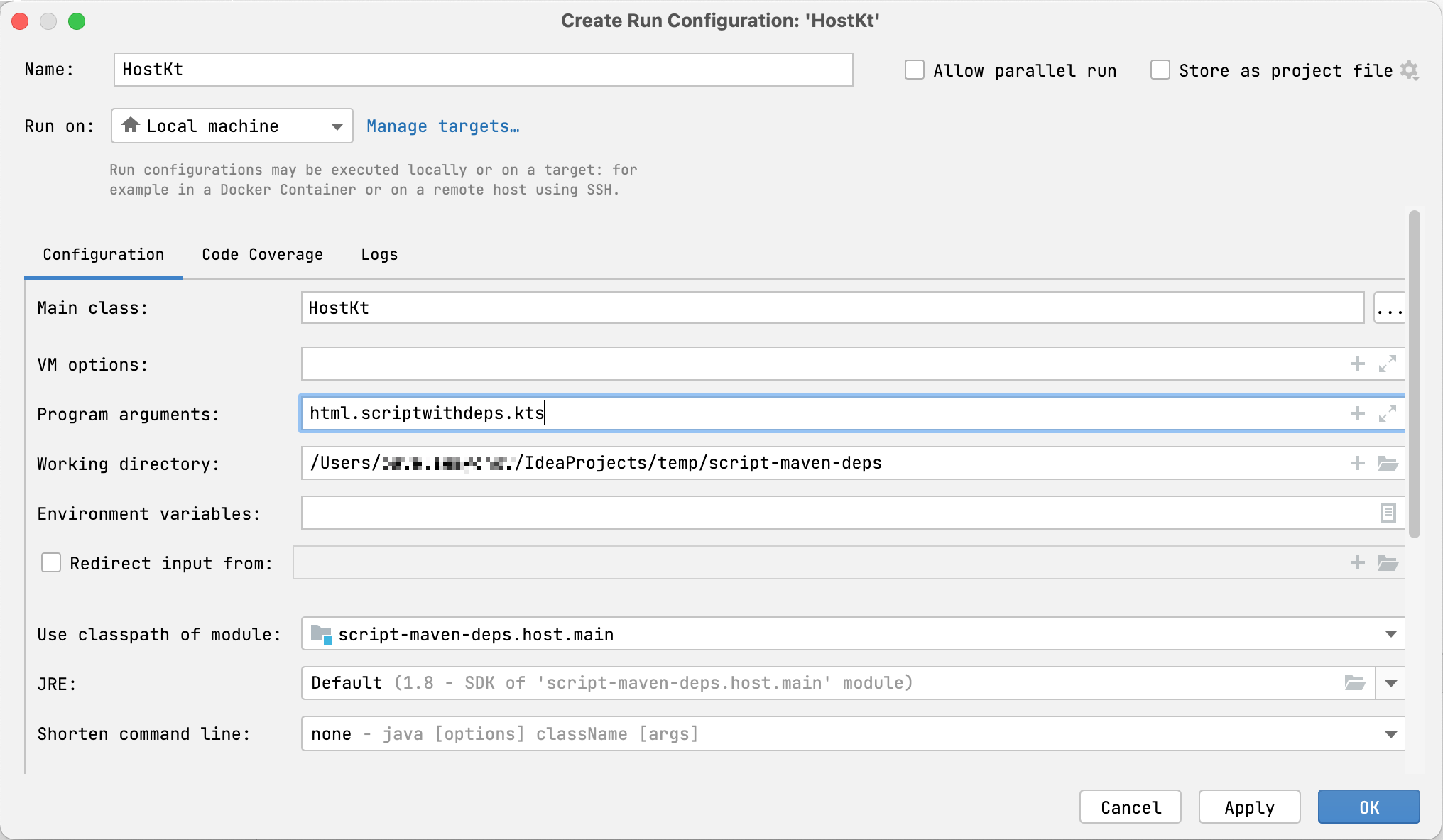Kotlin 自定义脚本入门教程
Kotlin 脚本 是一种技术,它允许将 Kotlin 代码作为脚本执行,而无需事先编译或打包成可执行文件。
有关带有示例的 Kotlin 脚本的概述,请查看 KotlinConf'19 上 Rodrigo Oliveira 的演讲 Implementing the Gradle Kotlin DSL。
在本教程中,您将创建一个 Kotlin 脚本项目,该项目执行带有 Maven 依赖项的任意 Kotlin 代码。 您将能够执行如下的脚本:
@file:Repository("https://maven.pkg.jetbrains.space/public/p/kotlinx-html/maven")
@file:DependsOn("org.jetbrains.kotlinx:kotlinx-html-jvm:0.7.3")
import kotlinx.html.*
import kotlinx.html.stream.*
import kotlinx.html.attributes.*
val addressee = "World"
print(
createHTML().html {
body {
h1 { +"Hello, $addressee!" }
}
}
)
指定的 Maven 依赖项(本例中为 kotlinx-html-jvm)将在执行期间从指定的 Maven 仓库或本地缓存中解析,并用于脚本的其余部分。
项目结构
一个最小的 Kotlin 自定义脚本项目包含两个部分:
- 脚本定义 – 一组参数和配置,用于定义应如何识别、处理、编译和执行此脚本类型。
- 脚本宿主(Scripting host) – 一个应用程序或组件,用于处理脚本编译和执行——实际运行此类型的脚本。
考虑到所有这些,最好将项目拆分为两个模块。
开始之前
下载并安装最新版本的 IntelliJ IDEA。
创建一个项目
-
在 IntelliJ IDEA 中,选择 File | New | Project。
-
在左侧的面板中,选择 New Project。
-
命名新项目,并在必要时更改其位置。
选中 Create Git repository 复选框,将新项目置于版本控制之下。 您可以随时在以后执行此操作。
-
从 Language 列表中,选择 Kotlin。
-
选择 Gradle 构建系统。
-
从 JDK 列表中,选择要在项目中使用的 JDK。
- 如果 JDK 已安装在您的计算机上,但未在 IDE 中定义,请选择 Add JDK 并指定 JDK 主目录的路径。
- 如果您的计算机上没有必要的 JDK,请选择 Download JDK。
-
为 Gradle DSL 选择 Kotlin 或 Gradle 语言。
-
点击 Create。

添加脚本模块
现在您有了一个空的 Kotlin/JVM Gradle 项目。 添加所需的模块,脚本定义和脚本宿主(Scripting host):
-
在 IntelliJ IDEA 中,选择 File | New | Module。
-
在左侧的面板中,选择 New Module。 此模块将是脚本定义。
-
命名新模块,并在必要时更改其位置。
-
从 Language 列表中,选择 Java。
-
如果要用 Kotlin 编写构建脚本,请选择 Gradle 构建系统和 Kotlin 作为 Gradle DSL。
-
作为模块的父级,选择根模块。
-
点击 Create。

-
在模块的
build.gradle(.kts)文件中,删除 Kotlin Gradle 插件的version。 它已经在根项目的构建脚本中。 -
再次重复之前的步骤,为脚本宿主(Scripting host)创建一个模块。
项目应具有以下结构:

您可以在 kotlin-script-examples GitHub repository 中找到此类项目的示例以及更多 Kotlin 脚本示例。
创建一个脚本定义
首先,定义脚本类型:开发人员可以在这种类型的脚本中编写什么以及如何处理它。
在本教程中,这包括支持脚本中的 @Repository 和 @DependsOn 注解。
-
在脚本定义模块中,在
build.gradle(.kts)的dependencies块中添加对 Kotlin 脚本组件的依赖项。 这些依赖项提供了您将需要的用于脚本定义的 API:- Kotlin
- Groovy
dependencies {
implementation("org.jetbrains.kotlin:kotlin-scripting-common")
implementation("org.jetbrains.kotlin:kotlin-scripting-jvm")
implementation("org.jetbrains.kotlin:kotlin-scripting-dependencies")
implementation("org.jetbrains.kotlin:kotlin-scripting-dependencies-maven")
// coroutines dependency is required for this particular definition
implementation("org.jetbrains.kotlinx:kotlinx-coroutines-core:1.10.1")
}dependencies {
implementation 'org.jetbrains.kotlin:kotlin-scripting-common'
implementation 'org.jetbrains.kotlin:kotlin-scripting-jvm'
implementation 'org.jetbrains.kotlin:kotlin-scripting-dependencies'
implementation 'org.jetbrains.kotlin:kotlin-scripting-dependencies-maven'
// coroutines dependency is required for this particular definition
implementation 'org.jetbrains.kotlinx:kotlinx-coroutines-core:1.10.1'
} -
在模块中创建
src/main/kotlin/目录,并添加一个 Kotlin 源文件,例如scriptDef.kt。 -
在
scriptDef.kt中,创建一个类。 它将是这种类型脚本的超类,因此将其声明为abstract或open。// abstract (or open) superclass for scripts of this type
abstract class ScriptWithMavenDeps此类稍后也将用作对脚本定义的引用。
-
要使该类成为脚本定义,请使用
@KotlinScript注解标记它。 将两个参数传递给注解:fileExtension– 以.kts结尾的字符串,用于定义此类型脚本的文件扩展名。compilationConfiguration– 一个 Kotlin 类,它扩展了ScriptCompilationConfiguration并定义了此脚本定义的编译细节。 您将在下一步中创建它。
// @KotlinScript annotation marks a script definition class
@KotlinScript(
// File extension for the script type
fileExtension = "scriptwithdeps.kts",
// Compilation configuration for the script type
compilationConfiguration = ScriptWithMavenDepsConfiguration::class
)
abstract class ScriptWithMavenDeps
object ScriptWithMavenDepsConfiguration: ScriptCompilationConfiguration()在本教程中,我们仅提供可用的代码,而没有解释 Kotlin 脚本 API。 您可以在 GitHub 上找到带有详细说明的相同代码。
-
如下所示定义脚本编译配置。
object ScriptWithMavenDepsConfiguration : ScriptCompilationConfiguration(
{
// Implicit imports for all scripts of this type
defaultImports(DependsOn::class, Repository::class)
jvm {
// Extract the whole classpath from context classloader and use it as dependencies
dependenciesFromCurrentContext(wholeClasspath = true)
}
// Callbacks
refineConfiguration {
// Process specified annotations with the provided handler
onAnnotations(DependsOn::class, Repository::class, handler = ::configureMavenDepsOnAnnotations)
}
}
)configureMavenDepsOnAnnotations函数如下:// Handler that reconfigures the compilation on the fly
fun configureMavenDepsOnAnnotations(context: ScriptConfigurationRefinementContext): ResultWithDiagnostics<ScriptCompilationConfiguration> {
val annotations = context.collectedData?.get(ScriptCollectedData.collectedAnnotations)?.takeIf { it.isNotEmpty() }
?: return context.compilationConfiguration.asSuccess()
return runBlocking {
resolver.resolveFromScriptSourceAnnotations(annotations)
}.onSuccess {
context.compilationConfiguration.with {
dependencies.append(JvmDependency(it))
}.asSuccess()
}
}
private val resolver = CompoundDependenciesResolver(FileSystemDependenciesResolver(), MavenDependenciesResolver())您可以在 此处 找到完整的代码。
创建一个脚本宿主(Scripting host)
下一步是创建脚本宿主(Scripting host)– 处理脚本执行的组件。
-
在脚本宿主(Scripting host)模块中,在
build.gradle(.kts)的dependencies块中添加依赖项:- Kotlin 脚本组件,提供脚本宿主(Scripting host)所需的 API
- 您先前创建的脚本定义模块
- Kotlin
- Groovy
dependencies {
implementation("org.jetbrains.kotlin:kotlin-scripting-common")
implementation("org.jetbrains.kotlin:kotlin-scripting-jvm")
implementation("org.jetbrains.kotlin:kotlin-scripting-jvm-host")
implementation(project(":script-definition")) // the script definition module
}dependencies {
implementation 'org.jetbrains.kotlin:kotlin-scripting-common'
implementation 'org.jetbrains.kotlin:kotlin-scripting-jvm'
implementation 'org.jetbrains.kotlin:kotlin-scripting-jvm-host'
implementation project(':script-definition') // the script definition module
} -
在模块中创建
src/main/kotlin/目录,并添加一个 Kotlin 源文件,例如host.kt。 -
为应用程序定义
main函数。 在其主体中,检查它是否具有一个参数 – 脚本文件的路径 – 并执行该脚本。 您将在下一步的单独函数evalFile中定义脚本执行。 现在将其声明为空。main可以如下所示:fun main(vararg args: String) {
if (args.size != 1) {
println("usage: <app> <script file>")
} else {
val scriptFile = File(args[0])
println("Executing script $scriptFile")
evalFile(scriptFile)
}
} -
定义脚本评估函数。 在这里您将使用脚本定义。 通过使用脚本定义类作为类型参数调用
createJvmCompilationConfigurationFromTemplate来获取它。 然后调用BasicJvmScriptingHost().eval,并将脚本代码及其编译配置传递给它。eval返回ResultWithDiagnostics的实例,因此将其设置为函数的返回类型。fun evalFile(scriptFile: File): ResultWithDiagnostics<EvaluationResult> {
val compilationConfiguration = createJvmCompilationConfigurationFromTemplate<ScriptWithMavenDeps>()
return BasicJvmScriptingHost().eval(scriptFile.toScriptSource(), compilationConfiguration, null)
} -
调整
main函数以打印有关脚本执行的信息:fun main(vararg args: String) {
if (args.size != 1) {
println("usage: <app> <script file>")
} else {
val scriptFile = File(args[0])
println("Executing script $scriptFile")
val res = evalFile(scriptFile)
res.reports.forEach {
if (it.severity > ScriptDiagnostic.Severity.DEBUG) {
println(" : ${it.message}" + if (it.exception == null) "" else ": ${it.exception}")
}
}
}
}
您可以在 此处 找到完整的代码
运行脚本
要检查脚本宿主(Scripting host)的工作方式,请准备一个要执行的脚本和一个运行配置。
-
在项目根目录中创建文件
html.scriptwithdeps.kts,其内容如下:@file:Repository("https://maven.pkg.jetbrains.space/public/p/kotlinx-html/maven")
@file:DependsOn("org.jetbrains.kotlinx:kotlinx-html-jvm:0.7.3")
import kotlinx.html.*; import kotlinx.html.stream.*; import kotlinx.html.attributes.*
val addressee = "World"
print(
createHTML().html {
body {
h1 { +"Hello, $addressee!" }
}
}
)它使用
kotlinx-html-jvm库中的函数,该库在@DependsOn注解参数中引用。 -
创建一个运行配置,该配置启动脚本宿主(Scripting host)并执行此文件:
-
打开
host.kt并导航到main函数。 它在左侧有一个 Run 间距图标。 -
右键单击间距图标,然后选择 Modify Run Configuration。
-
在 Create Run Configuration 对话框中,将脚本文件名添加到 Program arguments,然后单击 OK。

-
-
运行创建的配置。
您将看到脚本是如何执行的,从而解析指定仓库中对 kotlinx-html-jvm 的依赖关系并打印调用其函数的结果:
<html>
<body>
<h1>Hello, World!</h1>
</body>
</html>
在首次运行时,解析依赖关系可能需要一些时间。 后续运行将更快地完成,因为它们使用从本地 Maven 仓库下载的依赖关系。
接下来是什么?
创建了一个简单的 Kotlin 脚本项目后,请查找有关此主题的更多信息:
- 阅读 Kotlin scripting KEEP
- 浏览更多 Kotlin 脚本示例
- 观看 Rodrigo Oliveira 的演讲 Implementing the Gradle Kotlin DSL